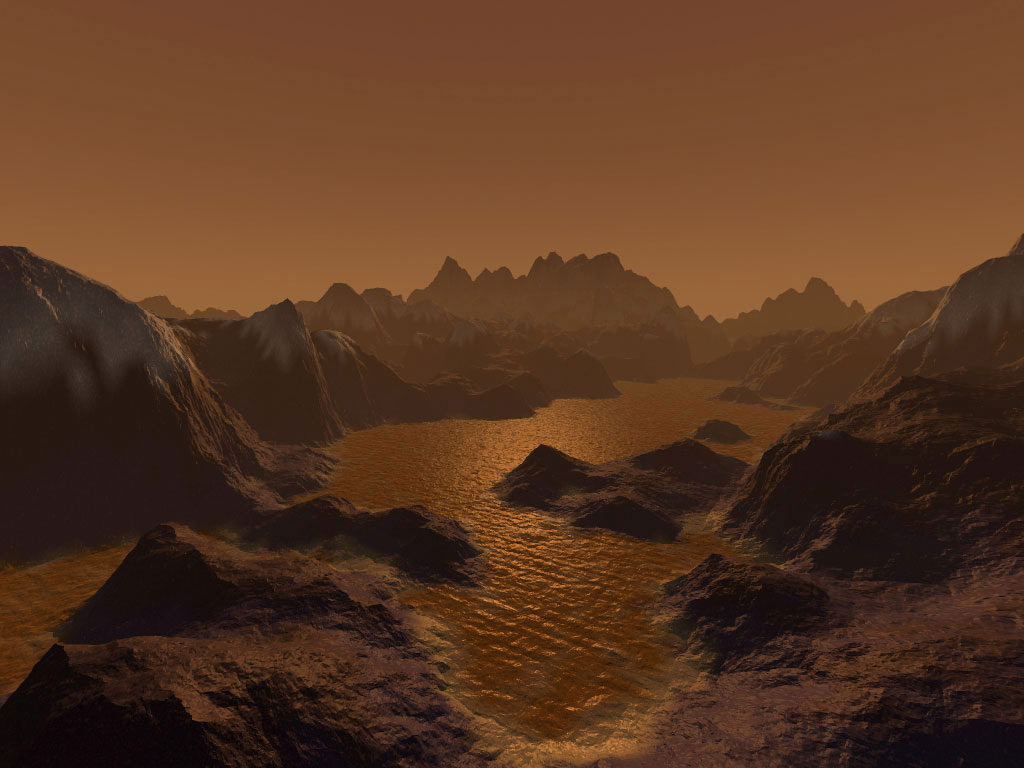

An artist's imagination of hydrocarbon pools, icy and rocky terrain on the surface of Saturn's largest moon Titan. Image credit: Steven Hobbs (Brisbane, Queensland, Australia).
[/caption]
Thanks to the Cassini mission and the Huygens probe, we’ve glimpsed a wet world when science took a look at Saturn’s moon, Titan. Its atmosphere is rich in methane and its average temperature is about -300 degrees Fahrenheit (about 90 kelvins). Although the chemical composition is different than ours, Titan still has similar features such as clouds, fog, rain and even lakes. However, the origin of these features haven’t really been well explained until now.
Researchers at the California Institute of Technology (Caltech) have been hard at work creating a computer program based on observations made by Cassini imaging and radar that could help explain Titan’s weather patterns and liquid surface deposits. One major oddity was discovered in 2009 when Oded Aharonson, Caltech professor of planetary science, and his team confirmed Titan’s lakes appeared to be gathered around its poles – more predominately in the northern hemisphere than compared to the south – yet that’s not the only curiosity. The areas around the equator were suspected to be dry, but the Huygens probe revealed areas of run-off and four years later researchers observed a storm system delivering moisture. Need more? Then check out the clouds observed by ground-based telescopes… They gather around southern middle and high latitudes during Titan’s southern hemisphere summer season.
“We can watch for years and see almost nothing happen. This is bad news for people trying to understand Titan’s meteorological cycle, as not only do things happen infrequently, but we tend to miss them when they DO happen, because nobody wants to waste time on big telescopes—which you need to study where the clouds are and what is happening to them—looking at things that don’t happen,” explains Mike Brown of the California Institute of Technology (Caltech).
Sure. The researchers have worked hard at creating models that could explain these exotic weather features, but such explanations involve way out theories, such as cryogenic volcanoes that blast out methane vapor to cause clouds. However, the latest computer renderings are much more basic – the principles of atmospheric circulation. “We have a unified explanation for many of the observed features,” says Tapio Schneider, the Frank J. Gilloon Professor of Environmental Science and Engineering. “It doesn’t require cryovolcanoes or anything esoteric.” Schneider, along with Caltech graduate student Sonja Graves, former Caltech graduate student Emily Schaller (PhD ’08), and Mike Brown, the Richard and Barbara Rosenberg Professor and professor of planetary astronomy, have published their findings in the January 5 issue of the journal Nature.
Why is this data set different than its predecessors? According the Schneider, these new simulations were able to reproduce cloud patterns which match factual observations – right down to the distribution of lakes. “Methane tends to collect in lakes around the poles because the sunlight there is weaker on average,” he explains. “Energy from the sun normally evaporates liquid methane on the surface, but since there’s generally less sunlight at the poles, it’s easier for liquid methane there to accumulate into lakes.” Because Titan has an elongated orbit, it’s a bit further away during the northern hemisphere summer allowing for a longer rainy season and thus a stronger accumulation of lakes.
So what about storms? Near the equator, Titan isn’t very exciting – or is it? Originally it was theorized the area was almost desert-like. That’s why when the Huygens probe discovered evidence of run-off, it became apparent that existing models could be wrong. Imagine the surprise when Schaller, Brown, Schneider, and then-postdoctoral scholar Henry Roe discovered storms in this supposedly arid region in 2009! No one could figure it out and the programs did little more than predict a drizzle. With the new model, heavy rains became a possibility. “It rains very rarely at low latitudes,” Schneider says. “But when it rains, it pours.”
So what else makes the new Titan weather computer model even more unique? This time it runs for 135 Titan years and links the methane lakes – and how methane is distributed – to its atmosphere. According to the research, this matches current Titan weather observations and will help to predict what could be seen in coming years. Making testable predictions is “a rare and beautiful opportunity in the planetary sciences,” Schneider says. “In a few years, we’ll know how right or wrong they are.”
“This is just the beginning,” he adds. “We now have a tool to do new science with, and there’s a lot we can do and will do.”
Original Story Source: California Institute of Technology News Release. For Further Reading: Caltech Scientists Discover Storms in the Tropics of Titan.
Every Martian year (which last 686.98 Earth days), the Red Planet experiences regional dust storms…
If Intermediate-Mass Black Holes (IMBHs) are real, astronomers expect to find them in dwarf galaxies…
There are plenty of types of stars out there, but one stands out for being…
As far as we can tell, life needs water. Cells can't perform their functions without…
Dubbed CADRE, a trio of lunar rovers are set to demonstrate an autonomous exploration capability…
Astronomers have identified sulfur as a potentially crucial indicator in narrowing the search for life…